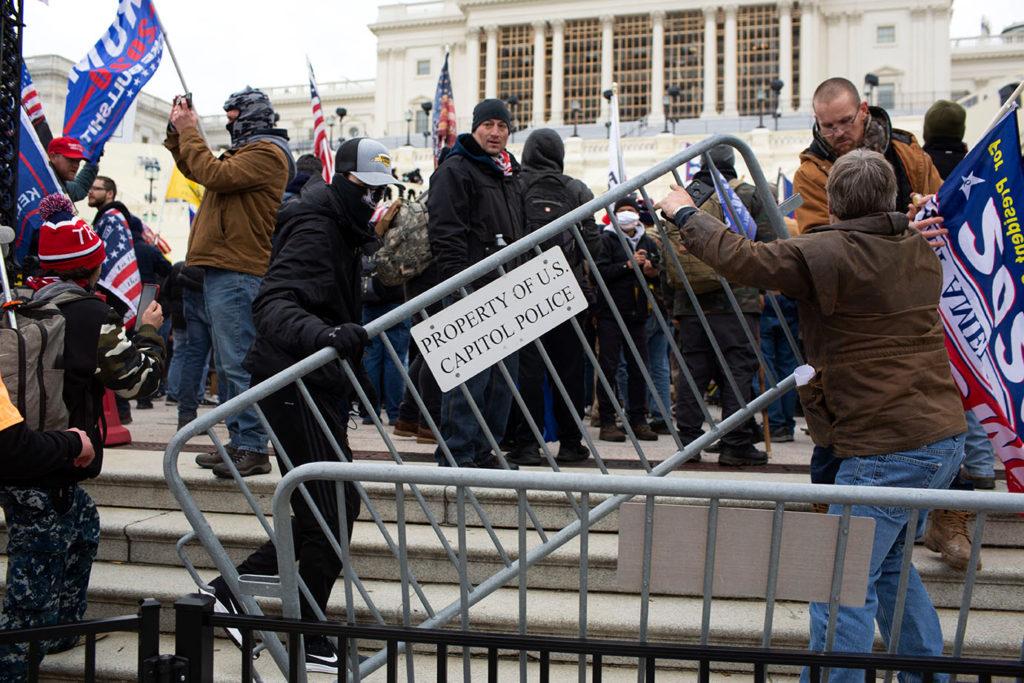A year after a mob of rioters stormed the U.S. Capitol, a GW research institute’s report compiling demographics on the more than 700 defendants federally charged in connection to the insurrection has gained national attention.
Research fellows from the Program on Extremism – a research center that analyzes forms of domestic and international extremism – published a report earlier this month detailing the age, gender, residence, political ideologies, extremist group affiliations and military history of 704 defendants who allegedly stormed the Capitol on Jan. 6. The New York Times, ABC News and the Boston Globe cited the report’s data to add statistical evidence to their news stories and social media posts about the insurrection’s one-year anniversary.
Bennett Clifford, a co-author of the report and a senior research fellow at the extremism program, said the 48-page report combines the arrest information from each insurrectionist’s court records with statistics from the program’s Capitol Hill Siege online database, which includes the percentage of rioters who pleaded guilty.
He said the team of researchers used the U.S. Department of Justice’s public court record system to access the available indictments of each defendant and worked with the geography department to determine the geographical origin of each rioter.
“Our main goal in putting that data out there is for people to be able to compare what other folks are saying about it to see what really holds muster or not because it’s one of the few primary source databases about what happened on Jan. 6 that’s available to the public,” he said.
Clifford said the report’s data shows how domestic extremism within the United States has become increasingly common in recent years because social media allows online extremist communities to easily share ideologies with one another.
He said only about 11 percent of the insurrectionists held ties to domestic violent extremist groups like the Proud Boys and the Oath Keepers prior to Jan. 6, and 11% possessed military experience. Men made up 87 percent of the total number of charged defendants, according to the report.
“It’s less important nowadays to understand what groups look like or what organizations look like and more important to understand what ideologies, what narratives and what trends look like in terms of the future of domestic violence and extremism,” Clifford said.
Alex Mallin, a DOJ reporter for ABC News, said he and other reporters used the database to report on the common factors among the rioters at the insurrection, including residential states, prior military involvement and previous federal charges. He said the data showed that the rioters were diverse in ideologies, geographic origin and demographics.
Of the 704 defendants, 135 have been between 20 and 29 years old at the time of their arrests, 189 between ages 30 and 39 and 141 between ages 40 and 49, according to the report.
“I think you obviously have to start from the ground up and look at the people who have been arrested and charged with the most violent crimes ranging from assault on officers down to the small misdemeanor cases of people who just walked into the Capitol and didn’t cause any damage,” Mallin said.
Maillin said journalists were able to gain a detailed understanding of the insurrectionists’ geographic diversity because the report showed that insurrectionists came from 45 U.S. states with a majority of them hailing from Florida and Texas. He said journalists who have covered the insurrection’s investigations haven’t have the time to analyze every court record belonging to those charged in connection to Jan. 6, but they could instead refer to the report for the insurrectionists’ demographic information.
“It’s invaluable for not just reporters but for the public and for historians who want to document this really singular event,” he said.
Experts in domestic terrorism and extremism said they found the report comprehensive because it included new national security strategies like the National Strategy for Countering Domestic Terrorism, which the federal government created in response to Jan. 6, in addition to the insurrectionists’ demographic diversity.
Matthew Kriner, a senior research scholar at the Center on Terrorism, Extremism and Counterterrorism at Middlebury College in Vermont, said the report showed how Jan. 6 was a “wakeup call” for the federal government because federal officials prioritized combatting international terrorism over domestic terrorism and extremism prior to the insurrection. He said the current federal investigation into the insurrection is the largest of its kind in U.S. history.
He said while past patterns of racially motivated militia activity resurged in the early 2010s with the emergence of domestic extremist groups, the constant change in these groups’ ideologies ultimately confused law enforcement officials and prevented them from identifying the Jan. 6 insurrectionists’ rise to extremism before the attack on the Capitol.
“If you’re expecting one thing to come, but in reality it looks entirely different but sounds similar, then you’re going to have a harder time adjusting to that change in the ecosystem,” he said.
The cases of the charged defendants were split into categories based on each defendant’s level of involvement with militant and domestic extremist groups, with 36% of defendants classified as inspired believers – or people who traveled alone to the Capitol – and 34 percent as organized clusters – people who planned to riot with family and friends. 9% were categorized as part of militant networks, which were the domestic extremist groups that gave direct commands to attack, according to the report.
Bruce Hoffman, a senior fellow for counterterrorism and homeland security at the Council on Foreign Relations, said the report dispels misinformation surrounding Jan. 6, like exaggerations of the role that active military service members played in the insurrection or the claim that Jan. 6 was not a significant political event.
“You have some people who view it as an insurrection for which some of the most senior elected officials in the United States played a role in,” he said. “Then you have others that diminish its significance or will argue that it was as one congressperson said ‘just like another tourist visit on the Hill.’”
Eddie Herzig contributed reporting.








